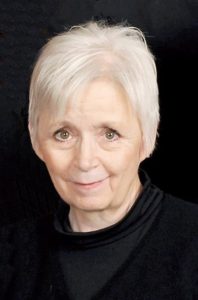Pat Schiltz’ personal experience with the dreaded polio
~by Chuck Offenburger for the Greene County Historical Society
 Pat Schiltz of Jefferson says if you weren’t yet alive in the 1950s, you probably have difficulty comprehending just how frightening and widespread an epidemic of the disease polio was back then when it swept the world. She was little Pat Beck then, 4 years old in 1955, when she began living the story right here in Greene County.
Pat Schiltz of Jefferson says if you weren’t yet alive in the 1950s, you probably have difficulty comprehending just how frightening and widespread an epidemic of the disease polio was back then when it swept the world. She was little Pat Beck then, 4 years old in 1955, when she began living the story right here in Greene County.
Almost everybody knew somebody who contracted polio, a virus which attacked the brain and spinal cord, especially in children. It commonly caused paralysis, great pain and in many cases death. At its peak, 500,000 people worldwide had the disease. One year, there were 58,000 cases in the U.S.
Government and philanthropists quick-launched massive research projects to develop a polio vaccine. In 1956 and ’57, nearly every school child in America and some adults were vaccinated. It seems miraculous now, looking back, to realize the disease was virtually eradicated, even more quickly than it had become an epidemic.
“I remember all the kids in the county went to the courthouse in Jefferson for the vaccinations,” Schiltz said. “They had doctors and nurses working there, and the pink vaccine was in sugar cubes that they gave each of us. Some other places had actual shots, but here we had the sugar cubes, and the serum had already been injected into them.”
Pat Beck Schiltz was cured of the actual disease, but has battled and occasionally suffered the rest of her life with “post-polio syndrome,” which challenges her energy level, sometimes leaves muscles aching and has compromised her immune system.
She’ll tell her personal story of a lifetime with polio in a program for the Greene County Historical Society on Friday, June 2, at Central Christian Church in Jefferson.
There will be lunch at 12 noon, $8 for Historical Society members, who should RSVP to their community contacts by Wednesday, May 31. Lunch for non-members is available, too, but for $10, and they can RSVP by calling vice-president Nancy Hanaman at 515-436-7684. The program at 1 pm at the church is free.
Schiltz said from the ages of 4 to 6, she received regular treatment for polio at the University of Iowa Hospital & Clinics in Iowa City. “I’d be in the hospital for about a week, then have a few days off, be back in the hospital for another stay,” she said. “My grandparents (Bill and Doris Pasler) lived in Belle Plaine then, which was a lot closer to Iowa City than Jefferson, so I stayed with them for a lot of that time.”
From 6 to 8 years old, she had to make twice-a-year trips to Iowa City for check-ups.
“I learned over time that polio had affected mostly the left side of my body,” Schiltz said. “So when I’d get tired, I’d get this dull ache that would become really intense in my left leg. That has continued, even as I got older. The doctors and nurses gave me ideas for trying to get through it – like rubbing alcohol on my leg, or using heat or ice. It’s always been ‘whatever you can do to be more comfortable.’ ”
Through her adult life, she’s emphasized fitness to help cope with “nerve-ending pain and muscle pain.” For years, “I’d walk three miles a day, but as I’ve aged, I just can’t do that anymore. I’m lucky now to walk half way around the block. And I really have no immune system now, so I have to be very careful about being exposed to other people when they’re sick.”
She said that in the 1950s, “people were just a little bit hesitant to be around you if you had polio, because they weren’t sure whether you’d be contagious or not. They were leery about it.”
Today, “people know I’m not well, and they wonder what I’ve gone through but are hesitant to ask. That’s one reason I look forward to telling the story at the historical program, and let people ask questions. Some of it has been really hard, but I don’t dwell on the bad part because, overall, I’ve been fortunate.”
She and her husband Gary Schiltz have grown children Sean Schiltz and Jennifer Schiltz, both living in Jefferson, and grandchildren Sydney and Sawyer Schiltz.
More information and details are available at www.greenecountyiowahistoricalsociety.org.
